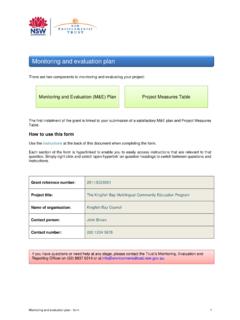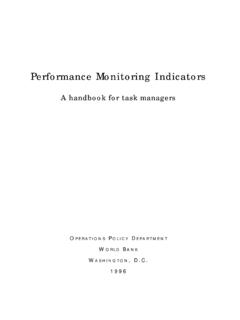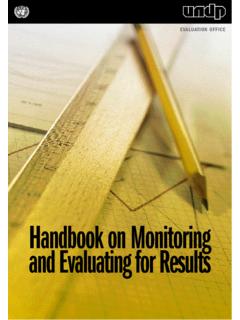Transcription of Introduction to Program Evaluation for Public Health …
1 Introduction to Program Evaluation for Public Health programs : A Self-Study Guide Suggested Citation: Department of Health and Human Services Centers for Disease Control and Prevention. Office of the Director, Office of Strategy and Innovation. Introduction to Program Evaluation for Public Health programs : A self-study guide. Atlanta, GA: Centers for Disease Control and Prevention, 2011. OCTOBER 2011 Acknowledgments This manual integrates, in part, the excellent work of the many CDC programs that have used CDC s Framework for Program Evaluation in Public Health to develop guidance documents and other materials for their grantees and partners. We thank in particular the Office on Smoking and Health , and the Division of Nutrition and Physical Activity, whose prior work influenced the content of this manual. We thank the following people from the Evaluation Manual Planning Group for their assistance in coordinating, reviewing, and producing this document.
2 In particular: NCHSTP, Division of TB Elimination: Maureen Wilce NCID, Division of Bacterial and Mycotic Diseases: Jennifer Weissman NCCDPHP, Division of Diabetes Translation: Clay Cooksey NCEH, Division of Airborne and Respiratory Diseases: Kathy Sunnarborg We extend special thanks to Daphna Gregg and Antoinette Buchanan for their careful editing and composition work on drafts of the manual, and to the staff of the Office of the Associate Director of Science for their careful review of the manual and assistance with the clearance process. Contents Page Executive Summary 3 Step 1: Engage Stakeholders .. 13 Step 2: Describe the Program .. 21 Step 3: Focus the Evaluation Design .. 42 Step 4: Gather Credible Evidence .. 56 Step 5: Justify Conclusions .. 74 Step 6: Ensure Use of Evaluation Findings and Share Lessons Learned .. 82 Glossary.
3 91 Program Evaluation Resources .. 99 Introduction to Program Evaluation for Public Health programs Executive Summary - 1 Executive Summary This document is a how to guide for planning and implementing Evaluation activities. The manual, based on CDC s Framework for Program Evaluation in Public Health , is intended to assist managers and staff of Public , private, and community Public Health programs to plan, design, implement and use comprehensive evaluations in a practical way. The strategy presented in this manual will help assure that evaluations meet the diverse needs of internal and external stakeholders. Such needs include assessing and documenting Program implementation, outcomes, efficiency and cost-effectiveness of activities, and taking action based on Evaluation results to increase the impact of programs . Why Evaluate Public Health programs ? Public Health programs aim to prevent or control disease, injury, disability and death.
4 Over time, as this task has become more complex, programs themselves have become more complex. Increasingly, Public Health programs address large problems, the solutions to which must engage large numbers of community members and organizations in a vast coalition. More often than not, Public Health problems which in the last century might have been solved with a vaccine or change in sanitary systems involve significant and difficult changes in attitudes and risk/protective behavior of consumers and/or providers. In addition, the context in which Public Health programs operate has become more complex. programs that work well in some settings fail dismally in others because of the fiscal, socioeconomic, demographic, interpersonal, and inter-organizational settings in which they are planted. At the same time that programs have become more complex, the demands for accountability from policymakers and other stakeholders have increased.
5 These changes in the environment in which Public Health programs operate mean that strong Program Evaluation is essential now more than ever. There is no one right Evaluation . Rather, a host of Evaluation questions may arise over the life of a Program that might reasonably be asked at any point in time. Addressing these questions about Program effectiveness means paying attention to documenting and measuring the implementation of the Program and its success in achieving intended outcomes, and using such information to be accountable to key stakeholders. Program Implementation Evaluation encourages us to examine the operations of a Program , including which activities take place, who conducts the activities, and who is reached as a result. In addition, Evaluation will show how faithfully the Program adheres to implementation protocols.
6 Through Program Evaluation , we can determine whether activities are implemented as planned and identify Program strengths, weaknesses, and areas for improvement. For example, a treatment Program may be very effective for those who complete it, but the number of participants may be low. Program Evaluation may identify the location of the Program or lack of transportation as a barrier to attendance. Armed with this information, Program managers can move the class location or meeting times or provide free transportation, thus enhancing the chances the Program will actually produce its intended outcomes. Introduction to Program Evaluation for Public Health programs Executive Summary - 2 Program Effectiveness The CDC and the Federal government have identified goals that Public Health programs should work toward to prevent or reduce morbidity and mortality.
7 Comprehensive Public Health programs use multiple strategies to address these goals. Typically, strategies are grouped into Program components that might include such elements as community mobilization, policy and regulatory action, strategic use of media and Health communication, and funding of frontline programs . Program Evaluation documents progress on Program goals and the effectiveness of various strategies in producing this progress . Program Accountability Program Evaluation is a tool with which to demonstrate accountability to an array of stakeholders who may include funding sources, policymakers, state, and local agencies implementing the Program , and community leaders. Depending on the needs of stakeholders, Program Evaluation findings may demonstrate that the Program makes a contribution to reducing morbidity and mortality or relevant risk factors; or that money is being spent appropriately and effectively; or that further funding, increased support, and policy change might lead to even more improved Health outcomes.
8 By holding programs accountable in these ways, Evaluation helps ensure that the most effective approaches are maintained and that limited resources are spent efficiently. This manual integrates insights from previous Framework-based manuals developed by CDC s Office on Smoking and Health ,1 and Division of Nutrition and Physical Activity2 for their grantees and state and local partners, and by the Center for the Advancement of Community Based Public Health for community Health programs3 as well as additional insights from conducting trainings and facilitations based on the Framework. The document is organized around Framework s six steps: Engage Stakeholders Describe The Program Focus The Evaluation Gather Credible Evidence Justify Conclusions Ensure Use of Evaluation Findings and Share Lessons Learned Each chapter illustrates the main points using examples inspired by real programs at the Federal, state, and local levels.
9 1 US Department of Health and Human Services. Introduction to Program Evaluation for comprehensive tobacco control programs . Atlanta, GA: US Department of Health and Human Services, Centers for Disease Control and Prevention, Office on Smoking and Health , November 2001. 2 US Department of Health and Human Services. Physical activity Evaluation handbook. Atlanta, GA: US Department of Health and Human Services, Centers for Disease Control and Prevention, 2002. 3 Center for Advancement of Community Based Public Health . An Evaluation framework for community Health programs . Durham, NC: Center for Advancement of Community Based Public Health , June 2000. Introduction to Program Evaluation for Public Health programs Page 3 Introduction What Is Program Evaluation ? Most Program managers assess the value and impact of their work all the time when they ask questions, consult partners, make assessments, and obtain feedback.
10 They then use the information collected to improve the Program . Indeed, such informal assessments fit nicely into a broad definition of Evaluation as the examination of the worth, merit, or significance of an object. 4 And throughout this manual, the term Program will be defined as any set of organized activities supported by a set of resources to achieve a specific and intended result. This definition is intentionally broad so that almost any organized Public Health action can be seen as a candidate for Program Evaluation : Direct service interventions ( , a Program that offers free breakfasts to improve nutrition for grade school children) Community mobilization efforts ( , an effort to organize a boycott of California grapes to improve the economic well-being of farm workers) Research initiatives ( , an effort to find out whether disparities in Health outcomes based on race can be reduced) Advocacy work ( , a campaign to influence the state legislature to pass legislation regarding tobacco control) Training programs ( , a job training Program to reduce unemployment in urban neighborhoods) What distinguishes Program Evaluation from ongoing informal assessment is that Program Evaluation is conducted according to a set of guidelines.
















